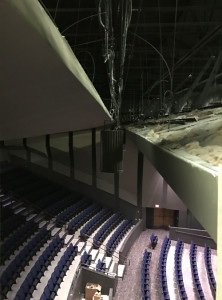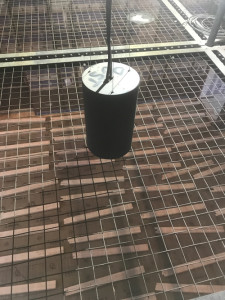House Light Integration
House Light Integration
Assuring LED House Light Compatibility with Theatrical Lighting Systems
House lights are as much a part of an auditorium as the stage, the catwalks and all of the other elements that make up a complete performance space. And, until recently, there was the simple expectation that the house light fixtures would typically be provided in the building’s electrical equipment package to be controlled by the theatrical and/or architectural dimming and control system. More often than not, the house light fixtures were specified by the electrical engineer as incandescent or quartz products connected to the dimmers designed by the theatre consultant. Now, however, the game has changed a bit.

View of a modern LED house light installed between the reflectors of a high school theatre, during construction. Photo by Andrew Gibbs, PhD, ASTC.
With the introduction of LED house lights, the installation and control parameters have evolved. Simply stated, the LED units have the ability to not only dim but in many cases change color (either white values or a full color spectrum) thus requiring more complex control and programming than the average incandescent control device can provide. Thus the integration with the theatre’s lighting system becomes more complex.
A number of matters come into play. First of all, unlike stage lighting fixtures, house lights may come from a variety of architectural lighting producers. (Yes, there are a few theatrical equipment firms that manufacture LED house lights, but they are still in the minority.) They are usually specified by the Electrical Engineer on the project and furnished and installed by the Electrical Contractor. However, unlike conventional house light fixtures, the LEDs require a low-voltage data cable for control purposes in addition to the line voltage wiring. Thus the Electrical Contractor has an added step in the installation, as well as the likelihood of having to “address” those fixtures (providing a data path), a procedure that may not be familiar. (Mains dimming and wireless control may alleviate those problems: see below.)
Once installed, it is usually the responsibility of the Theatrical Contractor to provide control of the house lights. Assuming that the specifications call for the house lights to be managed by the theatrical lighting system the Theatrical Contractor is tasked with terminating the LED data lines into the control system and establishing the necessary operating programs. And therein lies the greatest potential for difficulties. Unlike installing LED stage lighting equipment manufactured by a company that most likely built or is at least familiar with the stage dimming and control equipment, the Theatrical Contractor is faced with the following, sometimes confusing issues:
- House light LEDs manufactured by company “A”;
- House light LEDs installed by a contractor who could be unfamiliar with low-voltage data wiring;
- Potentially incompatible control methods: 0-10 volt; DMX; mains dimming or yet to be determined proprietary control protocols;
- Possible access issues for addressing each LED fixture;
- LED fixture manufacturer’s own control network that must be integrated with the theatrical control system.

Close-up of an LED house light installed over a Tension Wire Grid. The power and data cables can be seen entering the back of the light (as well as construction dust!) Photo by Jason Prichard.
Regardless of the myriad variables, the Theatrical Contractor is usually charged with “making it work”. While most Theatrical Contractors are indeed capable of solving the integration problems, many projects require inordinate efforts on the part of many of the players to make house light LED units perform as seamlessly as the rest of the auditorium’s equipment. In many cases, the interconnecting wiring is not in the Theatrical Contractor’s work, even if they are the most qualified to do so. There are good arguments for not requiring that contractor to wire the lights that are the responsibility of the Electrical Contractor.
What can be done to ease the integration?
- Clearly identify the house light control method in the theatrical specifications, making all the contractors aware of requirements for power AND data.
- Determine if hard-wired data cabling is appropriate and define its type: for example, DMX or 0-10 volt. Write this into the specifications.
- Move the house lights to the theatre lighting package. That way, the installing Theatrical Contractor would know in advance what the operating parameters are for the fixtures that he is responsible for controlling. This can be a schedule challenge and an issue considering the way lighting fixtures are often packaged.
- Encourage the theatrical dealer/contractors to offer house lights. House light manufacturers could make it financially practical for the theatre suppliers to sell those items. This could lead to a more direct path from specification to installation (and the better coordination we all seek.)
- Encourage more stage lighting manufacturers to invent or adopt a quality house light line. Several have already done so but there is need for more options.
- Encourage input from Architects and Electrical Engineers regarding the selection of fixtures but include the fixtures and installation under the theatrical scope.
- Assure, at specification time, that LED house light fixtures are easily accessible for programing OR assure that they are RDM (remote device management) compatible. RDM is a lighting protocol standard add on to DMX-512 which permits remote configuration and reporting, eliminating the need to access the light after installation.
- Consider “mains dimming” where data cable is not required. This is especially useful in retrofit installations, however the dimming curve may not be acceptable. Also consider “wireless DMX”. This is especially useful where access to fixtures or options to add low voltage wiring are a challenge. This is a good option in retrofit situations.
- Try to limit the number of decision makers (engineers, specifiers, related system designers) while still honoring the owners’ and architect’s wishes.
There’s a lot of value in using LEDs and similar solid-state lighting for the architectural lighting within the theatre. They are vastly more efficient with greatly reduced maintenance requirements. The ability to change color or control individual fixtures separately offer more possibilities. The challenge of specification and installation remains an ongoing issue, but one that’s worth the effort.
By D. Andrew Gibbs, PhD, ASTC


